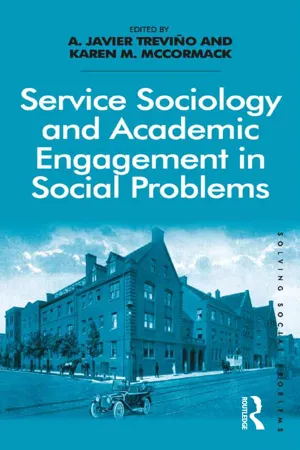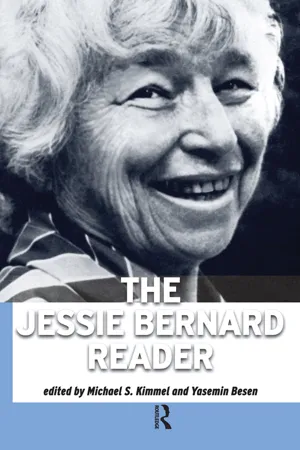Social Sciences
American Sociological Association
The American Sociological Association (ASA) is a professional organization for sociologists and individuals interested in the field of sociology. It promotes the study and understanding of society, social behavior, and social issues through research, publications, conferences, and educational programs. The ASA also provides resources and support for sociologists and promotes the application of sociological knowledge to address social challenges.
Written by Perlego with AI-assistance
3 Key excerpts on "American Sociological Association"
Learn about this page
Index pages curate the most relevant extracts from our library of academic textbooks. They’ve been created using an in-house natural language model (NLM), each adding context and meaning to key research topics.
- A. Javier Treviño, Karen M. McCormack(Authors)
- 2016(Publication Date)
- Routledge(Publisher)
Sociologist Randy Stoecker has always seen an inextricable connection between his scholarship and his community activism. Frustrated by mainstream sociology’s insulation from real-world, on-the-ground struggles for social justice, he argued in a 1996 article that it was high time for progressive sociologists to step forward and work to “restore the dignity of social action in sociology” (Stoecker 1996, n.p.).For years, the American Sociological Association (ASA) served as the institutional home and bastion of support for the academic model of sociology. Although some members dissented, it vigorously rejected the idea that social activism comprised a legitimate form of sociological practice. But it became clear that things were changing when, in 1999, the ASA elected radical scholar-activist Joe Feagin as its president. In his 2000 presidential address, Feagin pointed out that sociology must embrace rather than marginalize social activism as a valid and important professional activity. With respect to teaching specifically, he noted in his address that sociologists “should make clear to the coming generations of sociologists not only that there is plenty of room for idealism and activism in the field, but that these qualities might be required for humanity to survive the next century or so” (Feagin 2001, 14). Ellen Reese (2001) made the case that sociology professors should not just discuss activism in their courses, but engage in activism as mentors to their students. In my view, this is especially important given that many students enter college with negative stereotypes about social activists and social activism, a point I’ll return to shortly.That the ASA had changed its take on social activism became even clearer a few years later when progressive sociologist Michael Burawoy was elected to the presidency. Burawoy argued that sociology had for too long sequestered itself inside the “ivory tower,” that far too many sociologists spent more time talking to and writing for each other than they did sharing their ideas, energy and talents with a larger public, and that those who did engage a larger audience outside academia weren’t given the professional legitimacy and recognition they deserved. In essence, Burawoy called for a public sociology- eBook - ePub
Research Methods and Society
Foundations of Social Inquiry
- Linda Eberst Dorsten, Lawrence Hotchkiss(Authors)
- 2018(Publication Date)
- Routledge(Publisher)
Appendix 2Codes of Ethics
This appendix contains selected excerpts from (1) the American Sociological Association, (2) the British Sociological Association, (3) the Canadian Sociological Association, (4) the American Anthropological Association, (5) the Academy of Criminal Justice Sciences, (6) the South Asian Society of Criminology and Victimology (SASCV), and (7) the Association of Internet Researchers (contributors from Canada, Denmark, Finland, Japan, Sweden, Thailand, the U.K., and the U.S.).Other website URLs about ethics policy are listed at the end of this Appendix.American Sociological Association Code of Ethics
The American Sociological Association Code of Ethics consists of four major parts. Two of the parts under the current policy, General Principles and Ethical Standards, are listed below. For details, see the ASA website, listed below.General Principles
Principle A: Professional CompetencePrinciple B: IntegrityPrinciple C: Professional and Scientific ResponsibilityPrinciple D: Respect for People’s Rights, Dignity, and DiversityPrinciple E: Social ResponsibilityPrinciple F: Human RightsEthical Standards (Research)
Preamble
American Sociological Association. Code of Ethics of the ASA Committee on Professional Ethics. June 2018. www.asanet.org/sites/default/files/asa_code_of_ethics-june2018.pdf (accessed September 25, 2018).British Sociological Association—Ethical Practice Statement
The BSA Statement of Ethical Practice relevant to research consists of the following sections. For details, see the BSA website, listed below. - eBook - ePub
- Jessie Bernard, Michael S. Kimmel, Yasemin Besen(Authors)
- 2015(Publication Date)
- Routledge(Publisher)
2 But that first research program did open the door of the Society to the accelerating thrust of empirical research, give it official sanction, and provide it with a recognized forum. The rest is history. The research programs acquired prestige, proliferated into a veritable jungle, and all but overshadowed the theoretical papers. I leave for the official historians of the ASA the job of assessing the impact of this first revolution on the discipline and tracing its implications.My second revolution, in the 1930s, marked the emancipation of the Society from the fostering protection of the University of Chicago. Until that time, the University of Chicago had, in effect, owned the Society. It supplied the leadership, published the proceedings, and provided a home for the secretary treasurer. In the early 1930s, a group of rebels—led to a large extent by L. L. Bernard—stole the Society away.3 The American Journal of Sociology was no longer to be its official journal. Again I leave for the official historians of the ASA the task of assessing the impact of this second revolution on the discipline and tracing its implications.The third revolution, in the early 1950s, consisted of the declaration of independence of a group of rebels who, deploring the refusal of the parent organization to take a stand on any policy issue, established the Society for the Study of Social Problems (SSSP).4 Our gripes were manifold. We objected to the elitist direction the ASA was following, its lack of interest in social problems and issues, its antiseptic “line” on research, its cronyism, and its complacent acceptance of the increasing trend of putting sociological research at the service of business and industry. We were concerned also with protecting academic freedom in the era of McCarthy. The SSSP’s objectives were: (1) advancement of the study of social problems; (2) application of social science research to the formulation of social policies; (3) improvement of the opportunities and working conditions of social scientists; (4) protection of freedom of teaching, research, and publication; and (5) interdisciplinary cooperation in social science research.5 Although some of the stars of the ASA agreed to front for us,6 the actual leadership was in the hands of Alfred McClung Lee and Arnold Rose, who were not afraid to stand up to the conservative ASA elite. We embarrassed the ASA; it didn’t know exactly how to deal with us.7 For a long time, despite the shining stars—E. W. Burgess was the first president—we scared the elite by threatening to give sociology a bad name by taking positions on issues. But we were clearly in tune with the times. Before too many years had passed we became respectable. More’s the pity, perhaps. The most elite members of the ASA not only joined but became active. Became officers, in fact. We were not co-opted but the ASA did take over all the “radical” innovations we had introduced, and you can hardly tell the two apart anymore except that there may be more beards and slightly longer hair in the SSSP.8


